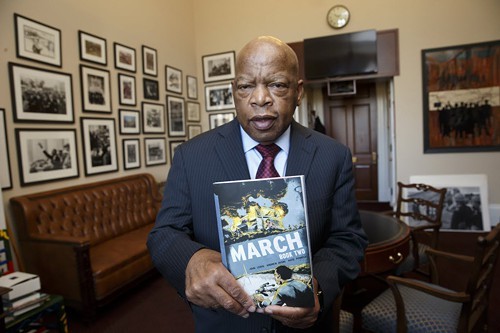March: Book Three by John Lewis, Andrew Aydin and Nate Powell
Written by Ashley Kelmore, Posted in Politics, Reviews
Five Stars
Best for: Anyone who thinks we don’t still need the voting rights act.
In a nutshell: This is the final – and longest – of three graphic novels about the life of John Lewis. It covers the mid-60s, culminating in the march from Selma to Montgomery and the passing of the voting rights act.
Line that sticks with me: “In Mississippi that summer we suffered more than 1000 arrests, 80 beatings, 35 shootings, 35 church burnings, and 30 bombings.”
Why I chose it: Because the first two books were great and I wanted to learn more.
Review: This final book covers a lot of ground, starting with a church bombing that killed four little girls, through voter registration drives that were accompanied by murders, and a peaceful march that ended up dubbed Bloody Sunday thanks to the vicious actions of the police.
It’s a rough read, but a critical one. I learned so much in the 250 pages, including more detail on some events that I had vaguely heard about previously. For example, I knew that the 1964 Democratic National Convention was contentious, but I didn’t know any of the details. It was so impressive to read about the very deliberate attempts to get the voices of the Mississippi Freedom Democratic Party heard.
Reading about the people who stood in line all day, not allowed to leave to drink water or use the bathroom, only to not be allowed to register to vote – or to be ‘allowed’ but then face ridiculously complicated literacy tests – was infuriating. Then to read about the passing of the voting rights act, and the triumph it was, only to be reminded about how the Supreme Court gutted it recently, leading to voter suppression during this most recent election. It’s like 20 steps forward, 19 steps back (forty years later).
Friday is going to happen, and some people will refer to the PEOTUS as President. Anyone who finds that deplorable but isn’t as well-educated on the past as they should be (like me) would be well advised to read this series to recognize what the fight for rights can look like.


